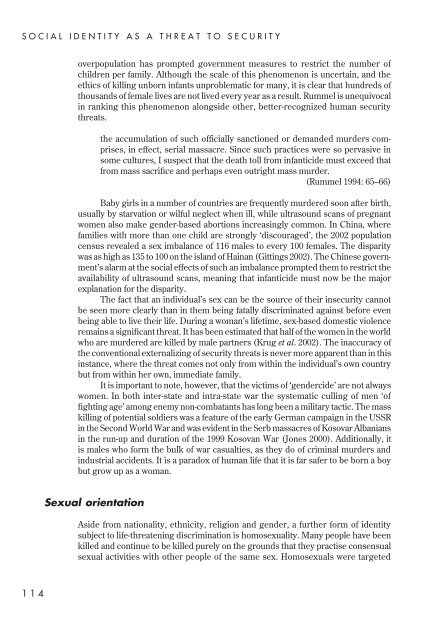Understanding global security - Peter Hough
Understanding global security - Peter Hough
Understanding global security - Peter Hough
You also want an ePaper? Increase the reach of your titles
YUMPU automatically turns print PDFs into web optimized ePapers that Google loves.
SOCIAL IDENTITY AS A THREAT TO SECURITY<br />
overpopulation has prompted government measures to restrict the number of<br />
children per family. Although the scale of this phenomenon is uncertain, and the<br />
ethics of killing unborn infants unproblematic for many, it is clear that hundreds of<br />
thousands of female lives are not lived every year as a result. Rummel is unequivocal<br />
in ranking this phenomenon alongside other, better-recognized human <strong>security</strong><br />
threats.<br />
the accumulation of such officially sanctioned or demanded murders comprises,<br />
in effect, serial massacre. Since such practices were so pervasive in<br />
some cultures, I suspect that the death toll from infanticide must exceed that<br />
from mass sacrifice and perhaps even outright mass murder.<br />
(Rummel 1994: 65–66)<br />
Baby girls in a number of countries are frequently murdered soon after birth,<br />
usually by starvation or wilful neglect when ill, while ultrasound scans of pregnant<br />
women also make gender-based abortions increasingly common. In China, where<br />
families with more than one child are strongly ‘discouraged’, the 2002 population<br />
census revealed a sex imbalance of 116 males to every 100 females. The disparity<br />
was as high as 135 to 100 on the island of Hainan (Gittings 2002). The Chinese government’s<br />
alarm at the social effects of such an imbalance prompted them to restrict the<br />
availability of ultrasound scans, meaning that infanticide must now be the major<br />
explanation for the disparity.<br />
The fact that an individual’s sex can be the source of their in<strong>security</strong> cannot<br />
be seen more clearly than in them being fatally discriminated against before even<br />
being able to live their life. During a woman’s lifetime, sex-based domestic violence<br />
remains a significant threat. It has been estimated that half of the women in the world<br />
who are murdered are killed by male partners (Krug et al. 2002). The inaccuracy of<br />
the conventional externalizing of <strong>security</strong> threats is never more apparent than in this<br />
instance, where the threat comes not only from within the individual’s own country<br />
but from within her own, immediate family.<br />
It is important to note, however, that the victims of ‘gendercide’ are not always<br />
women. In both inter-state and intra-state war the systematic culling of men ‘of<br />
fighting age’ among enemy non-combatants has long been a military tactic. The mass<br />
killing of potential soldiers was a feature of the early German campaign in the USSR<br />
in the Second World War and was evident in the Serb massacres of Kosovar Albanians<br />
in the run-up and duration of the 1999 Kosovan War (Jones 2000). Additionally, it<br />
is males who form the bulk of war casualties, as they do of criminal murders and<br />
industrial accidents. It is a paradox of human life that it is far safer to be born a boy<br />
but grow up as a woman.<br />
Sexual orientation<br />
Aside from nationality, ethnicity, religion and gender, a further form of identity<br />
subject to life-threatening discrimination is homosexuality. Many people have been<br />
killed and continue to be killed purely on the grounds that they practise consensual<br />
sexual activities with other people of the same sex. Homosexuals were targeted<br />
114
















